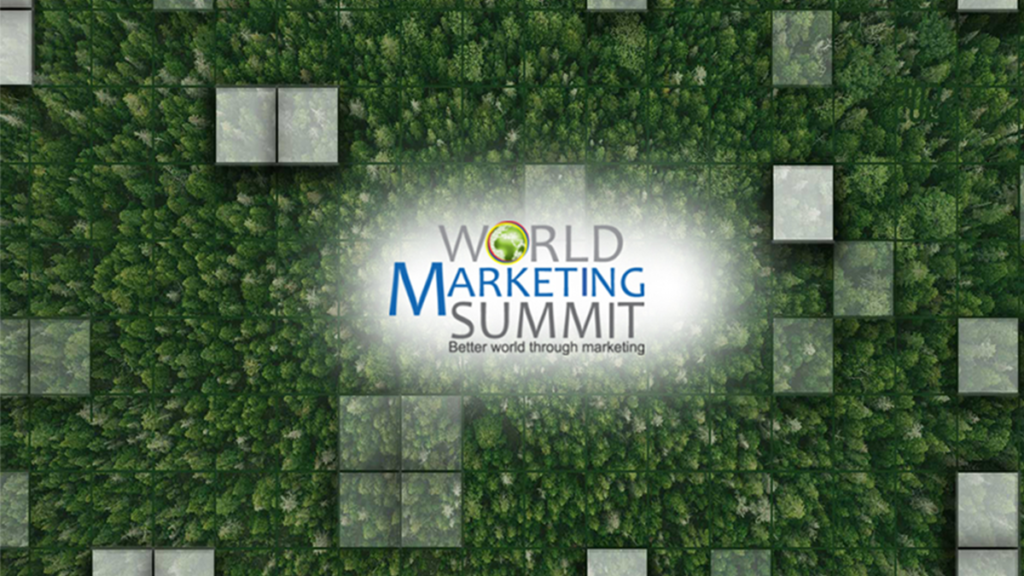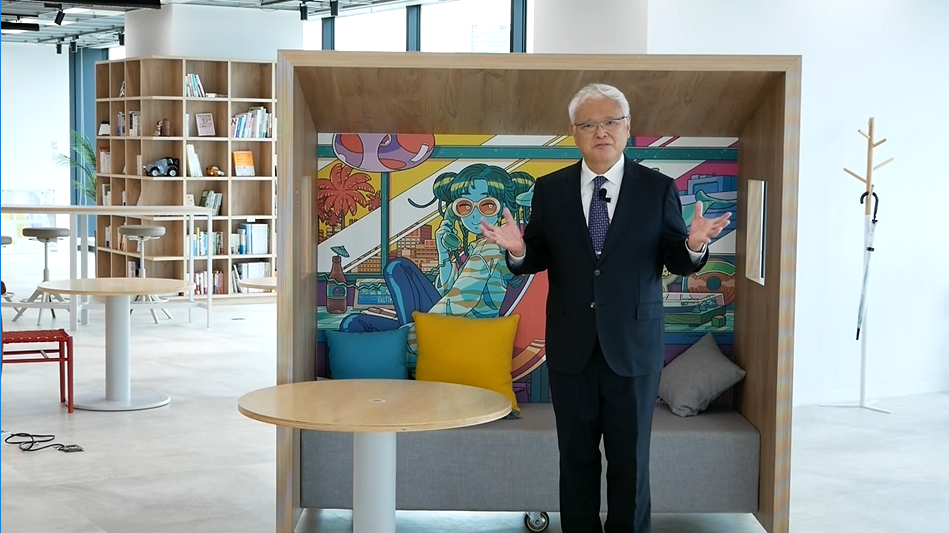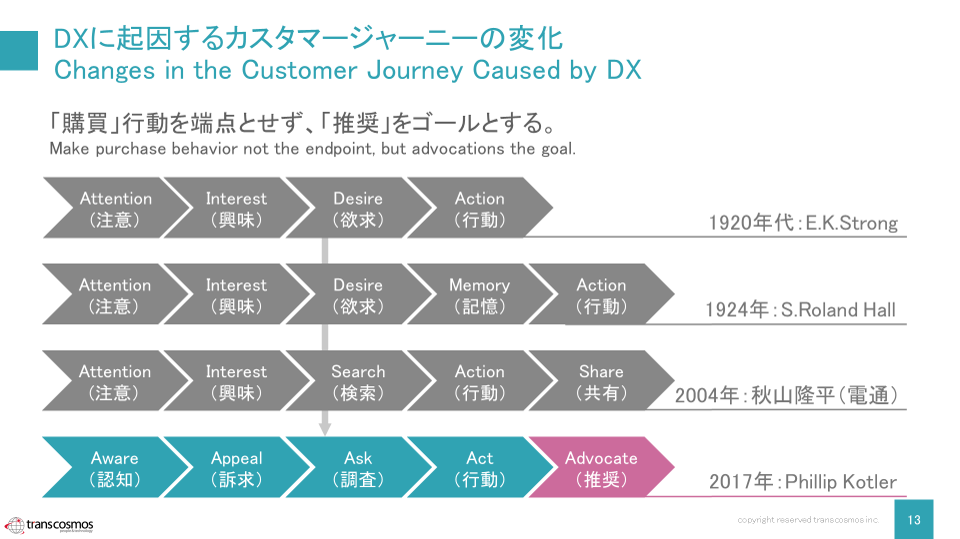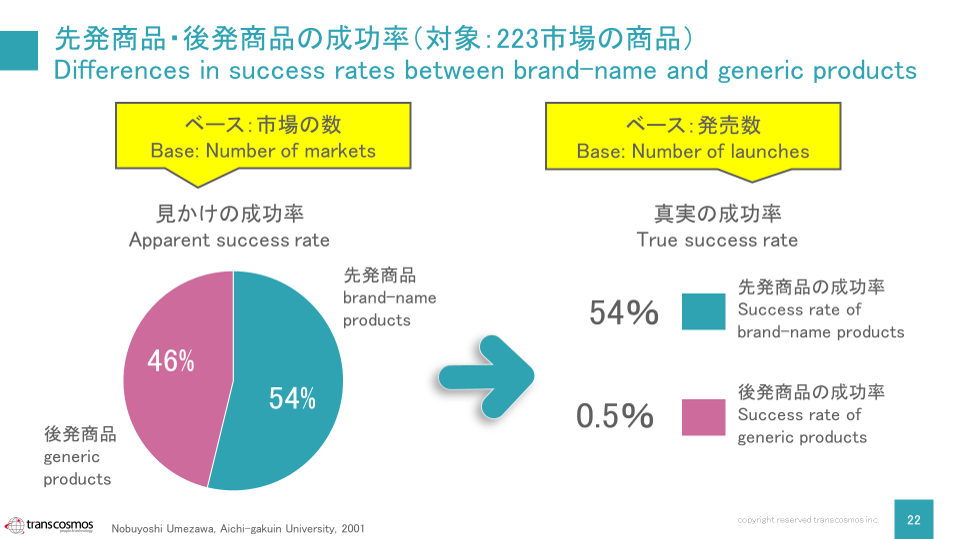The World Marketing Summit, initiated by Philip Kotler, the “father of modern marketing,” has been held in countries around the world under the philosophy of “A Better World through Marketing”. The World Marketing Summit has been held annually in Japan since 2014, and the 2021 event was held online from November 6 to 8. transcosmos (hereafter referred to as “our company”) Tsunehiro Fukushima took the stage along with more than 100 speakers including Prof. Philip Kotler, a world authority on marketing and management, and experts in the field. We have compiled an article on the content of his speech titled “The Future Opened Up by Loyalty Marketing and Market Creation,” in which he shared ideas about business in the new post-Corona era and explained solutions to social issues from a marketing perspective.

*Live Streaming is now closed.
Contents
Environment Surrounding Marketing
 I am giving this presentation from our new office that we opened in 2020. The project to open this office began in January 2020, shortly after the global COVID-19 epidemic spread. Telecommuting began, and the question was asked, “What will the after-corona way of working look like? The answer to this question was an open office, a free-address office. The spread of the new Coronavirus, COVID-19 and digital transformation (DX) has led to major changes in the way new offices are being set up. Similarly, it is expected that the future of marketing will also change significantly.
I am giving this presentation from our new office that we opened in 2020. The project to open this office began in January 2020, shortly after the global COVID-19 epidemic spread. Telecommuting began, and the question was asked, “What will the after-corona way of working look like? The answer to this question was an open office, a free-address office. The spread of the new Coronavirus, COVID-19 and digital transformation (DX) has led to major changes in the way new offices are being set up. Similarly, it is expected that the future of marketing will also change significantly.
First, I would like to consider the current marketing landscape. The most fundamental aspect of marketing is probably demographics. Through the Industrial Revolution and World Wars, the human population has been accelerating at a rapid pace. In the 21st century, however, this population trend has stagnated and in some countries, it has begun to decline. In some developed countries, population decline has already begun, and in Japan, it is expected to peak in 2008, followed by a gradual and accelerating decline. In contrast, only in the United States, population growth is expected to continue well into the 22nd century and beyond due to immigration policies.
With such a stagnant and declining population, what should we focus on to recognize our environment? In “Marketing 5.0,” published in February 2021, Professor Philip Kotler states that we must distinguish between “digital marketing” and “marketing in a digital society. Humanity has experienced many revolutions in the past. The Neolithic Revolution, the Industrial Revolution, and now the IT Revolution. In the Neolithic Revolution, mankind learned the art of agriculture, which led to a lifestyle of settling down on one piece of land and saying goodbye to hunger. What was the impact of the Industrial Revolution? The technological innovation of the Industrial Revolution was the steam engine. The steam engine, which produced a power so strong that humans had never thought possible before, dramatically increased productivity, improved quality of life, and transformed society and lifestyles.
So what kind of changes is the IT revolution that we are facing now bringing about? First of all, as you are probably well aware, the technological impact of the IT revolution includes high-speed computing, large-scale data handling, ultra-high-speed communications, and the Internet.
- High-speed operation:Technology has been created that can compute at speeds that humans can never imitate. The latest supercomputers are capable of calculating astronomical numbers.
- Large-scale data handling:The cost of storage has gone beyond Moore’s Law, and each year its cost has come down.
- Ultrahigh-speed communication:Experiments have been successful in transmitting a 34-volume encyclopedia at such ultra-high speeds that it transmits 100,000 times per second.
- The Internet:Naturally, we are now able to enter the network unconsciously.
However, since all of the above are technological aspects, it is important to consider not only this but also how these changes have affected lifestyles when considering them in marketing. The first is that “anyone can send and receive information worldwide at any time and any cost. I can read the blogs of strangers on the other side of the world at any time, freely and for free. The reverse is also true: anyone can listen to what I have to say at seminars and online conferences without any delay. Second, it is now possible to handle vast amounts of data such as ID-POS and various historical data. For example, it is common practice to store receipt data from all convenience stores in Japan in a single database. Third, as you all know, non-currency-based payment and savings are taking root in today’s society. And finally, the advent of AI, which itself may be called a revolution, has made it possible to automate even intellectual and creative tasks previously thought to be the domain of humans only.
I would like to talk about how the IT revolution has changed the flow of information in the world. Until now, the same information about brands and products from companies was shared with many people through mass media. In other words, the information was one-way and uniformly distributed from companies to consumers. The key point was how consumers received the information and changed their behavior and attitude when they came into contact with the information. In the digital society of the future, however, the transmission of information from a company is nothing more than the triggering of the information flow (the flow of information when products are provided from producers to consumers). Sei-katsu-sha that receive the information transmitted by the company repeatedly send and receive information from each other. It would be fair to say that this is a complex diffuse reflection of information.
In the digital society, it will no longer be possible to think of customers as gods and treat them in a different dimension. Rather, in this society, it is important for companies themselves to actively repeat receiving and sending information in the same dimension and space as consumers, and to be involved in the flow of information with the awareness that consumers are their friends.
Two environmental changes and two marketing changes resulting from these changes
The two environmental changes are the aforementioned stagnation of the population, which is turning into a declining trend, and the other is the rapid growth of digital transformation, which we recognize will be succeeded by AI. The important points I would like to discuss in my presentation are two new trends in marketing arising from these two environmental changes. One is the rapidly expanding importance of loyalty marketing (i.e., CX). The other is the need for market creation. The impact of this demographic trend and the development of DX on marketing has been accelerated by the expansion of the COVID-19 infection.
The Importance of Loyalty Marketing: The following diagram summarizes the evolution of the basic customer journey. Until now, the customer journey was structured as a decreasing funnel from left to right. In addition, at the end of the journey, there was always an action, such as a purchase or action. The latest customer journey, the “5A” proposed by Kotler, is characterized by the fact that the destination of the journey is no longer “purchase/act” but “recommendation/advocate”. In this respect, it is very similar to AISAS, but what makes the 5As decisively unique is that it does not have a funnel structure that decreases in order from left to right. In his book, Kotler describes the modern consumer as “going back and jumping over this journey.

And how will customer management change in such a society? I will explain how the way we make and maintain contact with our customers is changing. During the period of population growth, the market was growing year after year, and the number of consumers was increasing. In this period of growth, the key point was how to acquire new demand as quickly as possible. In other words, it could be described as a “hunting type”. On the subject of language, I think that in the past, marketing has often been likened to expressions related to “war.” Strategies”, “tactics”, etc., how to expand one’s own position and how to crush one’s enemies were directly linked to marketing’s KFS (Key Success Factor = Key Success Factor). This style of marketing will change drastically in the future as DX advances and population growth stagnates.
The way we relate to our customers will shift to an “agrarian” approach. The most important concept will be how to nurture the customers with whom we once have a relationship and who have connected with us, and how to nurture them up to the point where they become recommenders. One recommender leads to a new advocater, and this chain of recommenders spreads among consumers in the information flow I mentioned earlier. In other words, although marketing during the period of population expansion was described as a hunting type of marketing, from now on, rather an agrarian type of marketing will be necessary.
If “market size = population x total amount of value received by each customer,” then as long as the population does not increase, the growth issue for marketing will be how much value each customer receives. Furthermore, the way of contact with the customer does not end with the purchase of the product. The encounter between the customer and the product, the encounter before that, the exchange of information, social networking sites, call centers, chat rooms, and actual salespeople are all points of contact with the customer. All of these need to be considered as points of contact with the customer. We need to consider how to increase the loyalty of each customer and how to make them become a recommended customer through integrated management of this CX. We believe that this will be a major marketing challenge in the future.
The Need for Market Creation: Another growing challenge is the need for market creation. The advantage of market creation is that it is the only way to expand the market itself and has a high success rate. In today’s world of sustainability, the best solution is market creation, as Professor David Aker said at the Marketing Summit in 2019.
”The only way for a company to continue to grow is to change the game by creating subcategories (market creation).”
Professor Aker has been advocating the importance of this market creation from various angles for many years in his books. In Japan, Professor Nobuyoshi Umezawa has conducted a very unique study, and his research has led to the conclusion that “the success rate of MIP markets (market-initiated products) is 100 times higher than that of latecomer products. The results of tracking first-mover and latecomer products in 223 markets in Japan are shown in the figure. Although it may be difficult to assert the superiority of first-mover and generic products based on the apparent success rate, the fact is that there is only one first-mover product in a market. However, the number of generic products in the study was approximately 109. In other words, if we divide back based on the number of products launched, we find that the success rate of original products is 54% based on the number one market share, while the success rate of generic products is 0.5%, which means that a 100-fold difference is created.

Marketing Challenges in the DX Era: Summary
The following two points are important marketing issues required in the DX era.
One is customer strategy. The customer strategy required today is none other than loyalty marketing in strengthening the CX perspective. From now on, the most important marketing issue for companies will be to nurture true loyalty among their customers, not just their purchasing behavior. And while this is being done through CX activities, the scope of these activities will require a much broader perspective than marketing to date. These CX activities need to be managed in an integrated manner and must deal with a much larger number of variables than marketing has in the past. This is the task of the practitioner marketer.
Another is market strategy. We need to specialize in market-creating products in the future. We have entered an era in which it is no longer necessarily effective to compete in existing markets with differentiated products, and as we move from the 20th century, when the entire planet was expanding at once, to the stagnation and phenomenon of the IT revolution, we are now facing a major phase in which a new marketing strategy is necessary. We are now facing a major phase of the IT revolution, and new marketing is needed. It could be said that we are now at the greatest transformation point ever in the history of marketing.
Tsunehiro Fukushima will direct your marketing efforts.
At transcosmos, we offer marketing strategy proposals in line with the 5A concept advocated by Philip Kotler. For actual proposals, Tsunehiro Fukushima, the commentator of this article, supports loyalty marketing optimized for the digital age. Please contact us first to discuss your company’s concerns.
Tsunehiro Fukushima
Corporate Executive Officer, transcosmos inc.
Director, Japan Marketing Association
After completing graduate studies at the Tokyo Institute of Technology, he joined Ajinomoto Co., Inc. He then worked for GE Capital, Mitsubishi Corporation, Gurunavi, Inc., and Medical Data Vision Co., Ltd., where he served as head of big data business and marketing. His areas of expertise include new business and new product development, brand theory, medical business, and loyalty marketing. At transcosmos, he is in charge of marketing-related business development and is the exclusive provider in Japan of the 5A diagnosis introduced in the book “Kotler’s Marketing 4.0”.

